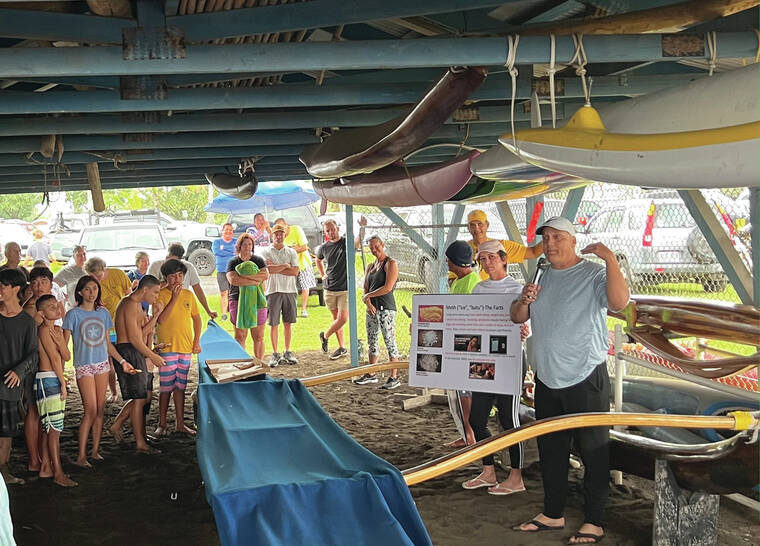A group of 50 keiki and parents gathered inside the Hui Wa‘a O Waiakea paddling hale at Hilo Bayfront on Monday to learn about the dangers of addiction and fentanyl on Hawaii Island.
“This drug (fentanyl) is the leading cause of death right now for everybody in our country ages 18 to 45,” Hawaii Island Fentanyl Task Force Leader Kimo Alameda told the crowd. “It’s 100 times more powerful than morphine, 50 times more powerful than heroin.”
Alameda mentioned that a recent death in the paddling community which occurred earlier this month led to Monday’s talk.
Steven Berengue, a 53-year-old paddling coach from the Big Island, was found June 4 by emergency responders at the Outrigger Reef Waikiki Beach Resort.
Berengue died, along with 44-year-old Joseph Iseke of Oahu, from a suspected fentanyl overdose after the synthetic opioid was detected at the scene. Three others were hospitalized, and their conditions are still unknown, although social media posts have claimed some of them are recovering.
Since then, the paddling community has stepped up to host special presentations about the dangers of fentanyl.
“We don’t want to wait until you guys turn 18, so we’re talking about it now,” Alameda said, who recently also gave a talk at the Puna Canoe Club. “Nobody goes from chocolate candy to fentanyl — there’s usually one gateway action that’s happening, where drugs lead to other drugs.”
Joining Alameda was pastor John Trusdell of Living Waters Assembly of God church.
“We don’t want to wait until after, until it affects somebody close to us,” Trusdell told the Tribune-Herald after the event. “For these kids, the more we can give them, and the more informed they are, the better.”
According to the Hawaii High Intensity Drug Trafficking Area, fentanyl-related deaths in Hawaii jumped from 48 deaths in 2021 to a record-high of 79 in 2022.
“This is what the kids need,” said paddling coach Kalani Young of the talk. “Some of the kids come from the charter school, and they have hard times. They’re sometimes the kids who other schools shove away. They’re in trouble and need help, so we try and build that here for them through things like this.”
The concept of addiction also was addressed during the presentation.
“You go from ‘I like it,’ to ‘I want it,’ and then you go to ‘I need it,’” Alameda told the crowd. “When you’re in ‘I need it’ — with alcohol, with marijuana, with vaping — you’re in trouble. That’s addiction.”
The task force also expressed the importance of Narcan, a medication used to rapidly reverse an opioid overdose.
In addition to demonstrating how the nasal spray works, roughly 20 packs of Narcan were given to attendees to help stop overdose deaths.
“Every house that gets pain medication should have one of these,” Alameda said of Narcan. “Kupuna are getting to the age where they forget — did I take my ten o’clock dose? I’m not sure, so at two o’clock I’m going to double up. That’s how some older people think, and now you’re in an overdose situation.”
While one person dies on the Big Island every 11 days from an overdose, three people are saved every 11 days due to the use of Narcan, according to the task force presentation.
“How do we know? Because the police and paramedics all get Narcan now,” Alameda said. “A fifth-grader saved his kupuna, his grandmother (with Narcan) in his house, because she was on pain medication.”
In May, the Hawaii Police Department reported 13 fentanyl-related arrests, more than any other month this year. HPD also reported recovering 87.53 grams of the drug along with 77 pills on the Big Island in May.
But as enforcement increases, Alameda hopes addressing demand also will stop the distribution of fentanyl and reduce overdose deaths.
“To decrease the supply is one way to solve the problem, but we also need to decrease the demand. How do we decrease the demand? Through education, right here,” he said. “If you’ve got plenty of milk in your house, but nobody drinks it, what will happen to the milk? It’s going to expire. Same thing with the drugs. If the drug dealers come, and they’re looking to push them but there’s no more customers, all of a sudden, the drugs are going to spoil, and the drug dealers are going to leave our island.”
Alameda has three more presentations scheduled next week in Waikoloa for various hotels.
Email Grant Phillips at gphillips@hawaiitribune-herald.com.

